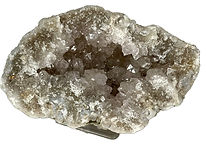
Lida Asteria
Geodes: Crack or Saw??
A lot of geodes we sell are beautiful whether you crack them, saw them or leave them whole. The most important information I can share with you today is that breaking open a rock that is millions of years old is bound to surprise you in some way. Keep this in mind, because no one knows what is inside this ancient rock until it is opened. Think of it as Mother Nature’s Art…each one is different, and it was created just as it was supposed to be. These grand geodes have endured the test of time. Have fun with it and enjoy natures beauty.
- One way to open a geode is the old-fashioned way........with a hammer! A rock hammer or plain-old carpenter's hammer will work for small geodes and a sledgehammer might be needed for larger ones.
If you choose to hammer your geode open. Look at your geode and see if there are any existing cracks or natural indentations. Start with light taps and build your way up. You only want to use enough force to start a crack, not shatter it into several pieces.
If you have a lot of Geodes to open, a tool we suggest using is a soil pipe cutter. These are plumber's tools, and can be bought online, or at some plumbing supply warehouses. Some models are manual, and others are hydraulic.
Another suggested purchase is a lighted Jewelers loupe.
Remember your Safety glasses and gloves and Have Fun!
The overall best way to open a filled or non-rattling geode (and most particularly, an agate) is to saw it. Diamond rock saws are made just for this purpose can be bought at rockhounding supply stores, eBay or Facebook.
Quartz Geode Cleaning Techniques
Some geodes are opened with basically clean quartz crystals and maybe some secondary minerals are present while other geodes are filled with clay, mud sediment and /or the crystals are stained with dissolved minerals from being exposed to the elements for millions of years. Mother Nature has taken over but there is still hope for these geodes with proper cleaning techniques. We will list several ways and you can decide on what is best for your geode. You can spend more or less time detailing your geodes to bring them to shelf quality.
Water - Hose off your geode and enjoy its sparkle. Use the Water Pik option to detail your Quartz.
Super Iron Out - sodium dithionate
1st solution for Iron staining and to clean residue due to dissolved minerals. Easy on the environment and no need to neutralize solution before disposal. Follow directions on the container. The process can take days to weeks. The solution is only good for a few days and it may require multiple batches to be produced.
Hydrochloric Acid or Muriatic acid – swimming pool acid or concrete acid
Fast acting aggressive acid that requires much safety precautions. Eyewear, chemical gloves, and proper ventilation are essential. This is the most aggressive method; protect yourself if you go this route. Be aware this acid will dissolve away most secondary minerals to quartz to include calcite, dolomite, and other alkaline minerals. Do a test to make sure you want to use this method. Only use plastic containers or buckets. If you dilute the acid, ONLY add acid to water, not water to acid. After a bath in acid for 5 minute or up to 5 days, dip in clean water then you will need to soak your geode in baking soda and water to neutralize the acid on your geode the water will fizz and continue cleaning out the acid. Then rinse and soak in clean water change water several times. If there is still clay, rocks, or mineral residue left on your geode, you can use a water pik to clean out your geodes cavity and rind. This process can take up to a week to complete. You can place the lid on the bucket to prevent children and animals from exposure (but provide a small vent hole for relieving gas pressure). To fully neutralize your old acid add baking soda, when it no longer fizzes then you can dispose of the acid safely.
Oxalic acid - white crystalline powder (Bar keepers friend, Rainbow –wood bleach)
Oxalic acid is easy to find, use and the safest for the home. It is used to dissolve the iron oxide (brown) stain on all minerals.
Bleach - If your Geode has organic material on it, like algae, use household bleach to clean it. Be sure to let it dry for a day before using any acid cleaning method.
Vinegar – A light acid
If your quartz crystals are encrusted with calcite, barite, or lime carbonates, you can try cleaning them with ordinary household vinegar and washing ammonia. You'll want to soak them for 8-12 hours in full-strength vinegar. Wash the crystals well, and then soak them for the same amount of time in washing ammonia. Rinse them well and wipe dry. If this helps remove the coating, but doesn't finish the job, you can try repeating the process a couple of times.


Soil pipe cutter



When sawed, you might find gorgeous crystals inside!!! This one is lightly coated in oil, but if it was polished, it would look even better!
Lapidary Saw

Cleaning with Iron Out







_edited.jpg)
